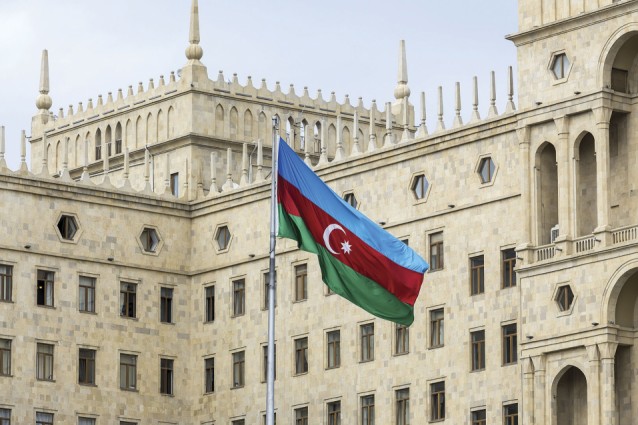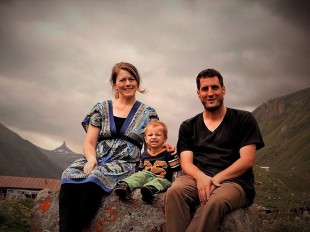The journey since Azerbaijan achieved independence from the Soviet Union 25 years ago may have been a bumpy one, but Azerbaijanis have much to be proud of, writes Luke Coffey, Director of the Foreign Policy Centre at the Heritage Foundation, a Washington DC-based think tank.
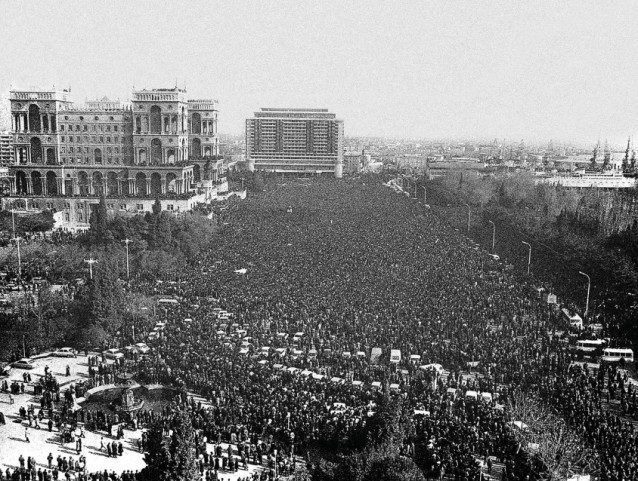 Crowds gather on Freedom Square (formerly Lenin Square) around the coffins of those killed during the events of Black January, 22 January 1990
Crowds gather on Freedom Square (formerly Lenin Square) around the coffins of those killed during the events of Black January, 22 January 1990
On 18 October 2016 the people of Azerbaijan will be celebrating the 25th anniversary of their independence from the Soviet Union. A lot has happened since 1991. Azerbaijan has been put firmly on the map thanks to its booming energy sector, and for cultural achievements like hosting the 2015 European Games, Eurovision Song Contest, and even a European Grand Prix. However, due to a war with Armenia in the early 1990s, and the subsequent occupation, Azerbaijan’s journey since independence has been a bumpy one.
As with most independence struggles around the world, the sacrifice of Azerbaijanis was great
Last year, during a trip to Baku, I took time to visit the cemetery and memorial at Martyrs’ Lane, formerly known as Kirov Park, on top of a hill overlooking the Caspian Sea. Today, the cemetery and memorial pays honour to those killed during the events of Black January in 1990.
A visit to Martyrs’ Lane is always a sombre experience. To a complete stranger—indeed a foreigner—like myself, the faces of those killed engraved on the shiny black marble tablets personalize the sacrifices made. Martyrs’ Lane is a stark reminder that independence does not come easily. Sacrifices are made. In some cases families are shattered and lives end.
The first glimpse of Azerbaijani self-determination appeared in 1988 when thousands of people could be seen protesting in Baku’s central square, now known as Freedom Square, against the central government in Moscow and Armenia’s designs on Nagorno-Karabakh.
However, it was not until January 1990 that Azerbaijan’s independence movement came of age. The events of 19-20 January 1990 that later became known as Black January marked the pinnacle of Azerbaijan’s struggle for independence. During this time 26,000 Soviet troops stormed Baku by order of the Kremlin as part of a failed and bloody attempt to squash Azerbaijan’s peaceful independence movement.
According to official estimates, somewhere between 131 and 170 civilians were killed, around 800 were injured, and five went missing, presumed dead. The violence was not limited to Baku, another two dozen peaceful protestors were also killed in the Lenkeran and Neftchala regions of Azerbaijan. This is why each year 20th January is commemorated as a day of national mourning.
Soviet leader Mikhail Gorbachev – who ordered the intervention – has admitted his mistake in dispatching the force to Baku. In 1995, he wrote:
The declaration of a State of Emergency in Baku was the biggest mistake of my political career.
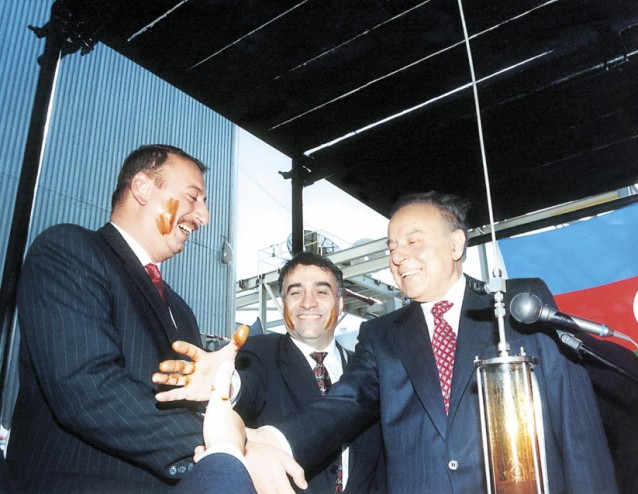 Then Azerbaijani President Heydar Aliyev, current Azerbaijani President Ilham Aliyev, and Natiq Aliyev, then President of SOCAR, celebrate the first oil production following the Contract of the Century, 12 November 1997
Then Azerbaijani President Heydar Aliyev, current Azerbaijani President Ilham Aliyev, and Natiq Aliyev, then President of SOCAR, celebrate the first oil production following the Contract of the Century, 12 November 1997
It is customary to pay one’s respects when visiting Martyrs’ Lane by placing red carnations on the memorials. I only had a dozen red carnations which was not enough to properly commemorate all those who made the ultimate sacrifice. As with most independence struggles around the world, the sacrifice of Azerbaijanis was great.
In retrospect, the events of Black January merely marked the beginning of the end for Azerbaijan’s struggle for independence. It would not be for another 20 months until Azerbaijan formally declared independence from the disintegrating Soviet Union.
However, this is not the first time that Azerbaijan has been independent. In May 1918 the Azerbaijan Democratic Republic was declared during the collapse of the Russian Empire and the fallout of the First World War. This endeavour, while noble, lasted only two years until the government in Baku surrendered to the Bolsheviks’ 11th Army troops in April 1920.
The challenges of independence
As with any newly independent country, especially one carrying the heavy burden of communism’s legacy, a newly independent Azerbaijan faced many challenges. During the first few years of independence the economy was a mess. The country was in a recession, unemployment was rampant, and hyperinflation was a serious problem.
The transition from a centrally planned economy to a market-based one was no easy task. After great hardship the situation began to improve by the mid-1990s. The signing of the Contract of the Century (more on that later) was a pivotal point in the economic transition of post-Soviet Azerbaijan. Yet, it wasn’t until 2009 that the government declared an official end to Azerbaijan’s post-independence economic transition.
The transition from a centrally planned economy to a market-based one was no easy task
Azerbaijan had an additional challenge during its early days of statehood. During the early days of independence any move to grow the economy, reform the country’s governing structures, or improve the wellbeing of the people was overshadowed by war.
The conflict between Armenia and Azerbaijan started before independence in 1988 when the Armenian Soviet Socialist Republic made territorial claims on Soviet Azerbaijan’s Karabakh Autonomous Oblast. This action resulted in a bloody war which ended up with Armenian forces and Armenian-backed militias illegally occupying almost 20 per cent of the territory that the international community recognizes as part of Azerbaijan. These occupied areas include: the Nagorno–Karabakh region and all or part of Lachin, Kelbajar, Aghdam, Fuzuli, Jebrayil, Qubadli, and Zangelan rayons and are still occupied today.
The war had a devastating effect on the country’s social fabric. Thousands of Azerbaijanis were killed and thousands more wounded. In addition, 875,000 more Azerbaijanis became displaced. Even though most of the Internally Displaced Peoples (IDP) are capable of working, they do not have permanent jobs and have to make their living on random incomes and meagre governmental allowances. While the government has done a lot to improve their welfare, the scale of the problem is immense.
It is heartbreaking meeting with these IDPs. I’ve heard firsthand stories of families shattered and homes lost forever. With satellite imagery readily available on the internet, IDPs are now able to view their old homes—the houses they left behind because of the war—with new cars in the drive; presumably owned by the new Armenian occupants. A whole generation of Azerbaijanis will never know what home really is because of the Armenian occupation— they will only know the challenging life in an IDP settlement.
In 1993, the UN Security Council adopted four resolutions on the Nagorno–Karabakh war. Each resolution confirmed the territorial integrity of Azerbaijan to include Nagorno–Karabakh and the seven surrounding districts and called for the withdrawal of all occupying Armenian forces from Azerbaijani territory. To this day these resolutions have not been implemented by Armenia.
The warring parties signed a cease-fire agreement in 1994, and the conflict has been “frozen” since then. The Minsk Group, tasked with bringing a lasting end to the war, remains the recognized mediating body but in 20 years has produced no sign of a resolution to the conflict. Since August 2014, violence has increased noticeably along the Line of Contact between Armenian and Azerbaijani forces. This violence reached a peak recently in April 2016.
During four days of fighting dozens of Azerbaijani soldiers were killed but this sacrifice was not in vain. Approximately 800 hectares of previously occupied land was liberated. This modest liberation represents the biggest change in territory between the two warring sides since the 1994 ceasefire was agreed. Today, Armenia’s occupation of parts of Azerbaijan is no different from Russia’s illegal occupation of Crimea in Ukraine or its occupation of South Ossetia and Abkhazia in Georgia.
A wealth of resources
War or no war, occupation or not, Azerbaijan is blessed with immense natural resources which should quickly form the backbone of the country’s economy and the nation’s post-Soviet recovery.
While the country was dealing with the fallout from Armenia’s invasion a serious effort began to get Azerbaijan’s oil and gas resources on the world market. At first no Western oil consortium was willing to take on the risk. Extracting the resources was one thing, getting them out of the region to the wider world was the main problem. Finally, when Azerbaijan and Armenia signed a ceasefire in May 1994, this created the stability needed in the region for foreign investment in the energy sector.
Azerbaijan emerged on the world stage as a major energy power during the 1990s. In 1994, it signed the “Contract of the Century” agreement with BP and 10 other international oil companies to open up the country’s vast resources in the Caspian Sea. Since 1994, Azerbaijan’s GDP has increased 16 times. It is worth pointing out that the benefits of Azerbaijan’s oil and gas sector transcends the whole economy: even the non-oil sector of the economy has increased tenfold since 1994.
The deal approved a $7.4 billion investment over 30 years in three offshore fields: Azeri, Chirag and Guneshli. The Contract of the Century celebrated its 20th year anniversary in 2014, and in many ways marked a new historical era for Azerbaijan. This agreement was the foundation for Azerbaijan to sign 26 other contracts that encompass 19 countries and 41 other oil companies. As of 2014 SOCAR estimates that since the Contract of the Century, roughly $50 billion has been invested in the Azerbaijani petroleum industry and that efficient marketing practices added cumulative additional revenues of $1.1 billion for Azerbaijan during 2008-2013. Put simply, the Contract of the Century was game changing for Azerbaijan.
Another milestone in Azerbaijan’s emergence as a key energy player occurred in 2005 when the Baku–Tbilisi–Ceyhan pipeline pumped its first oil to the Mediterranean Sea. This crucial pipeline was later joined by the South Caucasus Pipeline and the modernized Kars–Tbilisi–Baku railway.
Other pipelines are in the works too. In March 2015, construction started on the Trans-Anatolian Natural Gas Pipeline, further linking Azerbaijan to Turkey and the outside world. Construction is expected to be finished by 2018. Azerbaijan has also taken advantage of being the only country in the world to border both Russia and Iran, making it a crucial part of the International North–South Transport Corridor. This transit corridor is expected to compete with the Suez Canal by reducing transit costs between Russia in the north and India in the south and everything in between.
25 years ago, the idea that Azerbaijan would become one of the most important countries on the Eurasian continent in terms of energy transit and regional trade would have been unbelievable. Today, it is a reality.
As always in Azerbaijan tensions with Armenia are never far away. At their closest points the BTC pipeline and the South Caucasus Pipeline run within about 18 kilometres of the Line of Contact between Armenian-occupied Nagorno-Karabakh and Azerbaijani forces.
After a rough few years of independence that featured war, occupation and hardship, the Contract of the Century and the BTC pipeline placed Azerbaijan firmly on the map and was a much needed boost of national confidence.
A global player
Today, Azerbaijan has come a long way since those early and uncertain days of a new republic. It is a regional economic leader in the South Caucasus and an important economic actor in the Caspian region. Azerbaijan has been admitted to nearly all major international institutions, including to the International Monetary Fund, World Bank, European Bank for Reconstruction and Development, Islamic Development Bank, and Asian Development Bank. Globally, Azerbaijan is trying to keep a balance in its relations with the West and Russia. Regionally, Azerbaijan has sought to keep a balance between Russia and Iran while striving to preserve its autonomy or independence as much as possible.
Over the years Azerbaijan has developed a good relationship with the US—a relationship which dates back to its first independence in 1918. Azerbaijan was a staunch ally during the Iraq and Afghanistan campaigns, and Baku has contributed greatly to US counterterrorism efforts since 9/11. Azerbaijan is part of NATO’s Partnership for Peace program and participates in Alliance training exercises and officer exchanges. Although it is not actively seeking to join NATO, it participates in NATO-led missions and has close relations with other NATO members and partners, including Turkey and Georgia.
Ties between Azerbaijan and Europe have also been growing over the past 25 years. The official relationship it has with the European Union began with the signing of the Partnership and Cooperation Agreement (PCA) on 22 April, 1996. This agreement is a basic statement regarding cooperation in human rights, political dialogue, trade, investment, and other areas. Since the 1990s there have been increasingly closer relations. Azerbaijan established a Permanent Mission to the EU in 2000, and became the 43rd member state of the Council of Europe in 2001. The country has been a European Neighbourhood Policy and Eastern Partnership member since 2009.
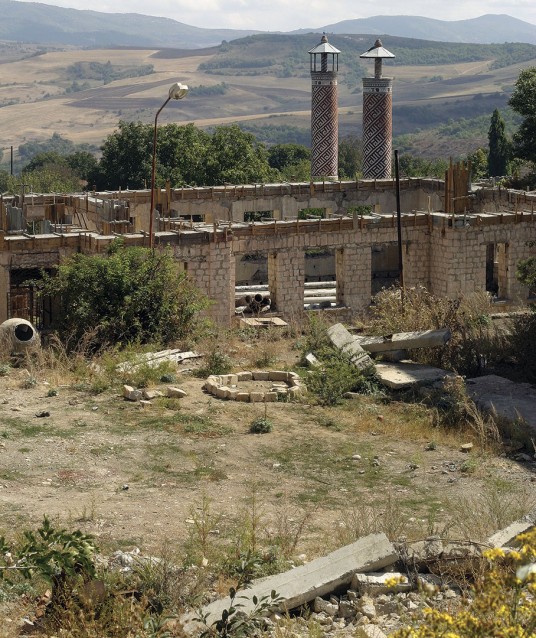 The ruins of Aghdam, a once thriving town in Nagorno-Karabakh populated mainly by Azerbaijanis. It was taken by Armenian forces in July 1993 and has since become a ghost town
The ruins of Aghdam, a once thriving town in Nagorno-Karabakh populated mainly by Azerbaijanis. It was taken by Armenian forces in July 1993 and has since become a ghost town
Many in Azerbaijan understand the economic implications from close cooperation with the EU. In economic development, EU members have invested billions of dollars in Azerbaijan, and the EU is Azerbaijan’s largest export/import market. If correct policies are pursued, Azerbaijan will serve as an important alternative source of energy for Europe well into the future.
Azerbaijan has come a long way since 1991 and its people have a lot to be proud of. Notwithstanding its location in a turbulent region Azerbaijan has a bright future ahead of it. Outside observers of Azerbaijan must be aware of one important point: everything the government in Azerbaijan does must be seen through the lens of Armenia’s occupation of Nagorno-Karabakh.Everything the government in Azerbaijan does must be seen through the lens of Armenia’s occupation of Nagorno- Karabakh
